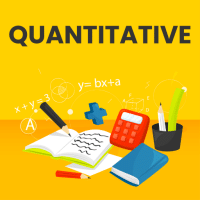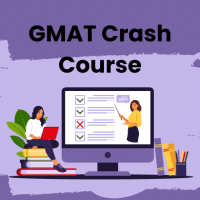GMAT Exam > GMAT Questions > If negative integers k and p are NOT both eve...
Start Learning for Free
If negative integers k and p are NOT both even, which of the following must be odd?
- a)kp
- b)4 (k + p)
- c)k - p
- d)k + 1 - p
- e)2 (k + p) - 1
Correct answer is option 'E'. Can you explain this answer?
Verified Answer
If negative integers k and p are NOT both even, which of the following...
Step 1: Analyze the Question
For this abstract number properties question, we can either apply the rules for odd and even numbers directly or simply pick some numbers to solve the question.
For this abstract number properties question, we can either apply the rules for odd and even numbers directly or simply pick some numbers to solve the question.
Step 2: State the Task
We must determine which answer choice must always be odd or, in other words, eliminate any answer choices that can be even.
We must determine which answer choice must always be odd or, in other words, eliminate any answer choices that can be even.
Step 3: Approach Strategically
For some number properties questions, using rules (if you are certain of them) is faster than Picking Numbers. In this question, the condition that k and p are negative and are "not both even" complicates Picking Numbers but not applying rules. Since we have rules for odd and even numbers, we can apply them directly to the answer choices. We start with (E), since this is a "which of the following" question. (E): Because 2 times any value is even, 2(k + p) will always be even. Subtracting one from an even number will always result in an odd number. Therefore, (E) is always odd and must be the correct answer.
For some number properties questions, using rules (if you are certain of them) is faster than Picking Numbers. In this question, the condition that k and p are negative and are "not both even" complicates Picking Numbers but not applying rules. Since we have rules for odd and even numbers, we can apply them directly to the answer choices. We start with (E), since this is a "which of the following" question. (E): Because 2 times any value is even, 2(k + p) will always be even. Subtracting one from an even number will always result in an odd number. Therefore, (E) is always odd and must be the correct answer.
Step 4: Confirm Your Answer
You can confirm your answer by noting that (A) through (D) could be even, judging by odd and even rules. (B) is always even, for example. (A) is odd when k and p are both odd, but the question stem allows for the possibility that one of them is even, and in such a case kp is even.
You can confirm your answer by noting that (A) through (D) could be even, judging by odd and even rules. (B) is always even, for example. (A) is odd when k and p are both odd, but the question stem allows for the possibility that one of them is even, and in such a case kp is even.
Most Upvoted Answer
If negative integers k and p are NOT both even, which of the following...
Understanding the Problem
We are given two negative integers, \( k \) and \( p \), that are not both even. This means at least one of them is odd.
Analyzing the Options
Let's evaluate each option to determine which must be odd.
Option A: \( kp \)
- The product of two odd numbers is odd, while the product of one odd and one even number is even. Since we don’t know the parity of \( k \) and \( p \) definitively, \( kp \) may be odd or even.
Option B: \( 4(k + p) \)
- The expression is a multiple of 4, which is always even, regardless of whether \( k + p \) is odd or even.
Option C: \( k - p \)
- This can be odd or even depending on the values of \( k \) and \( p \). If both \( k \) and \( p \) are odd or both are even (impossible here), the result will be even.
Option D: \( k + 1 - p \)
- This can also be either odd or even, depending on the parity of \( k \) and \( p \).
Option E: \( 2(k + p) - 1 \)
- Here, \( k + p \) must be odd (since one of \( k \) or \( p \) is odd). Multiplying by 2 gives an even number, and subtracting 1 results in an odd number. Therefore, \( 2(k + p) - 1 \) must be odd.
Conclusion
Thus, the only expression that must always be odd is:
Answer: Option E: \( 2(k + p) - 1 \)
We are given two negative integers, \( k \) and \( p \), that are not both even. This means at least one of them is odd.
Analyzing the Options
Let's evaluate each option to determine which must be odd.
Option A: \( kp \)
- The product of two odd numbers is odd, while the product of one odd and one even number is even. Since we don’t know the parity of \( k \) and \( p \) definitively, \( kp \) may be odd or even.
Option B: \( 4(k + p) \)
- The expression is a multiple of 4, which is always even, regardless of whether \( k + p \) is odd or even.
Option C: \( k - p \)
- This can be odd or even depending on the values of \( k \) and \( p \). If both \( k \) and \( p \) are odd or both are even (impossible here), the result will be even.
Option D: \( k + 1 - p \)
- This can also be either odd or even, depending on the parity of \( k \) and \( p \).
Option E: \( 2(k + p) - 1 \)
- Here, \( k + p \) must be odd (since one of \( k \) or \( p \) is odd). Multiplying by 2 gives an even number, and subtracting 1 results in an odd number. Therefore, \( 2(k + p) - 1 \) must be odd.
Conclusion
Thus, the only expression that must always be odd is:
Answer: Option E: \( 2(k + p) - 1 \)

|
Explore Courses for GMAT exam
|

|
Question Description
If negative integers k and p are NOT both even, which of the following must be odd?a)kpb)4 (k + p)c)k - pd)k + 1 - pe)2 (k + p) - 1Correct answer is option 'E'. Can you explain this answer? for GMAT 2025 is part of GMAT preparation. The Question and answers have been prepared according to the GMAT exam syllabus. Information about If negative integers k and p are NOT both even, which of the following must be odd?a)kpb)4 (k + p)c)k - pd)k + 1 - pe)2 (k + p) - 1Correct answer is option 'E'. Can you explain this answer? covers all topics & solutions for GMAT 2025 Exam. Find important definitions, questions, meanings, examples, exercises and tests below for If negative integers k and p are NOT both even, which of the following must be odd?a)kpb)4 (k + p)c)k - pd)k + 1 - pe)2 (k + p) - 1Correct answer is option 'E'. Can you explain this answer?.
If negative integers k and p are NOT both even, which of the following must be odd?a)kpb)4 (k + p)c)k - pd)k + 1 - pe)2 (k + p) - 1Correct answer is option 'E'. Can you explain this answer? for GMAT 2025 is part of GMAT preparation. The Question and answers have been prepared according to the GMAT exam syllabus. Information about If negative integers k and p are NOT both even, which of the following must be odd?a)kpb)4 (k + p)c)k - pd)k + 1 - pe)2 (k + p) - 1Correct answer is option 'E'. Can you explain this answer? covers all topics & solutions for GMAT 2025 Exam. Find important definitions, questions, meanings, examples, exercises and tests below for If negative integers k and p are NOT both even, which of the following must be odd?a)kpb)4 (k + p)c)k - pd)k + 1 - pe)2 (k + p) - 1Correct answer is option 'E'. Can you explain this answer?.
Solutions for If negative integers k and p are NOT both even, which of the following must be odd?a)kpb)4 (k + p)c)k - pd)k + 1 - pe)2 (k + p) - 1Correct answer is option 'E'. Can you explain this answer? in English & in Hindi are available as part of our courses for GMAT.
Download more important topics, notes, lectures and mock test series for GMAT Exam by signing up for free.
Here you can find the meaning of If negative integers k and p are NOT both even, which of the following must be odd?a)kpb)4 (k + p)c)k - pd)k + 1 - pe)2 (k + p) - 1Correct answer is option 'E'. Can you explain this answer? defined & explained in the simplest way possible. Besides giving the explanation of
If negative integers k and p are NOT both even, which of the following must be odd?a)kpb)4 (k + p)c)k - pd)k + 1 - pe)2 (k + p) - 1Correct answer is option 'E'. Can you explain this answer?, a detailed solution for If negative integers k and p are NOT both even, which of the following must be odd?a)kpb)4 (k + p)c)k - pd)k + 1 - pe)2 (k + p) - 1Correct answer is option 'E'. Can you explain this answer? has been provided alongside types of If negative integers k and p are NOT both even, which of the following must be odd?a)kpb)4 (k + p)c)k - pd)k + 1 - pe)2 (k + p) - 1Correct answer is option 'E'. Can you explain this answer? theory, EduRev gives you an
ample number of questions to practice If negative integers k and p are NOT both even, which of the following must be odd?a)kpb)4 (k + p)c)k - pd)k + 1 - pe)2 (k + p) - 1Correct answer is option 'E'. Can you explain this answer? tests, examples and also practice GMAT tests.

|
Explore Courses for GMAT exam
|

|
Signup for Free!
Signup to see your scores go up within 7 days! Learn & Practice with 1000+ FREE Notes, Videos & Tests.


















